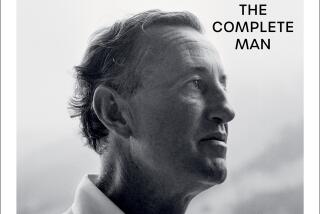From the 007 files, with love: They wrote the book on Bond
- Share via
Over the past four decades, James Bond films have had a weird, almost surreal impact on the real spy world.
During the opening weekend of one of the recent Bond films, the CIA set up a recruiting booth at theaters. “When the Army was putting together an urban assault vehicle called the SmarTruck, they sat down and watched Bond films,” says John Cork, coauthor with Bruce Scivally of the new coffee table book “James Bond: The Legacy” (Harry Abrams).
“The CIA has this entire thing called the ‘James Bond syndrome,’ ” Cork says. “It is when agents defect and become double agents. What they want is the glamorous Bond lifestyle as opposed to the real drudge work of intelligence. Even way back in the early ‘70s, G. Gordon Liddy was a tremendous Bond fan. If you read his book ‘Will’ -- the sections on the Watergate burglaries, the prose is right out of Ian Fleming.”
Cork notes that Bond’s world “isn’t our world, but it’s close enough to our world that you can dabble in it. If you are fortunate enough to have deep enough pockets, you can dress like Bond, you can drive Bond’s cars and you can eat the same kind of food.” And of course drink the same type of shaken, not stirred, martinis.
“James Bond: The Legacy” doesn’t only go in depth into Fleming’s creation of 007 in the 1950s, the 320-page book also is filled with rare photographs and odd facts about 007. (Among them: More than 70 million of Fleming’s 14 Bond books have been published since 1953; “Goldfinger,” the first Bond movie to air on TV, was first televised -- on ABC -- on Sept. 17, 1972; Bond’s gadgets in “On Her Majesty’s Secret Service” included a combination safecracker and photocopying machine.) Cork and Scivally are hard-core Bondphiles, having produced, written and directed 30 documentaries for MGM’s releases of the Bond films on DVD.
“My first memory of seeing any movie in any movie theater was ‘From Russia With Love,’ ” Cork recalls. “As an adolescent I became a huge fan when I saw ‘Live and Let Die.’ When you are 11 years old and a boy, and you are right on the cusp of adolescence and you don’t know how to ask a girl to dance at a party, and you suddenly see this character who has a great certainty of self, a great deal of self-confidence, and knows how to handle himself in any situation. That is how I wanted to be.
“I don’t drink vodka martinis very often. I drive a Volvo station wagon, but those things that are within the character -- that sense of purpose and self-confidence -- are masculine ideals that you really want to have. Bond embraces a worldliness which I find very refreshing, particularly growing up in Montgomery, Ala.”
Scivally became hooked on Bond upon seeing Connery in “Goldfinger” when it first aired on ABC in September 1972. He and Cork met at USC in the mid-1980s. “We had a couple of other friends, and we used to get together in the dorms and play a 1960s James Bond board game,” Scivally recalls.
The suave secret agent has endured the test of time and five incarnations, Scivally says, “because Bond is like Madonna. He keeps reinventing himself. I think there are certain core things that remain the same in the series, but the approach the films and the different actors playing the roles take are different as time goes on.
“Roger Moore is a different Bond than Sean Connery was. Then when Timothy Dalton came along I really liked him because he brought some dignity back to the role, but once Pierce Brosnan started playing it, I realized the thing Dalton lacked that Brosnan, Roger Moore and Sean Connery have in spades is charm.”
More to Read
Only good movies
Get the Indie Focus newsletter, Mark Olsen's weekly guide to the world of cinema.
You may occasionally receive promotional content from the Los Angeles Times.











